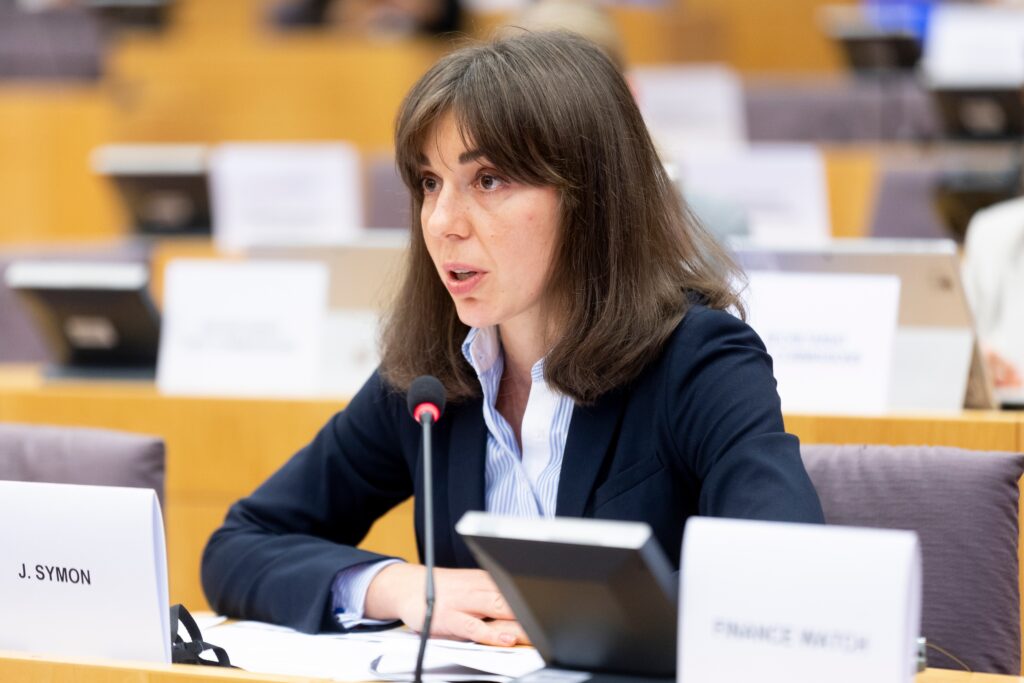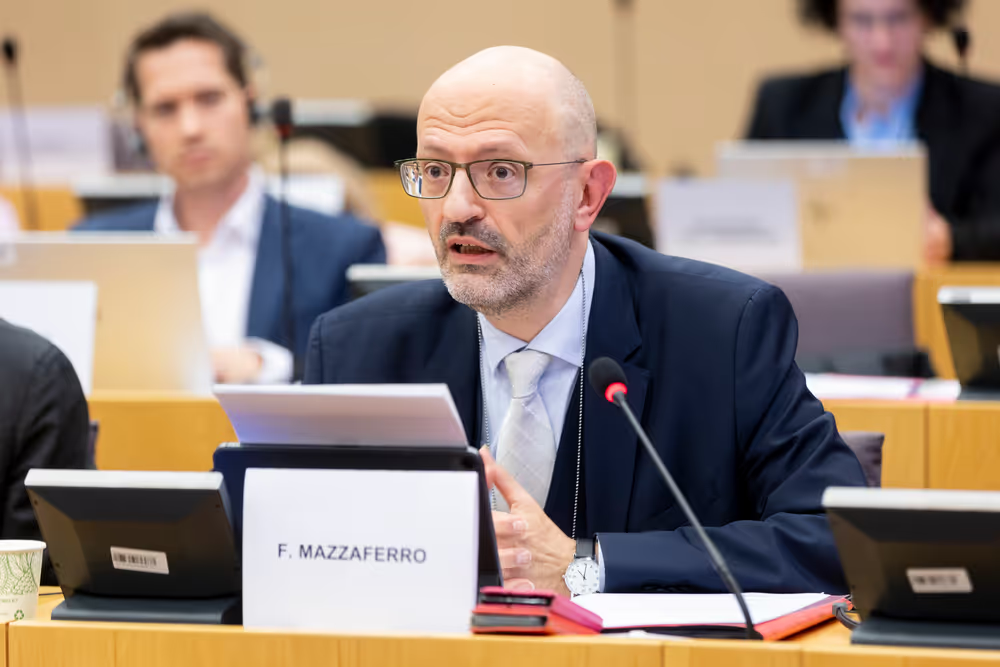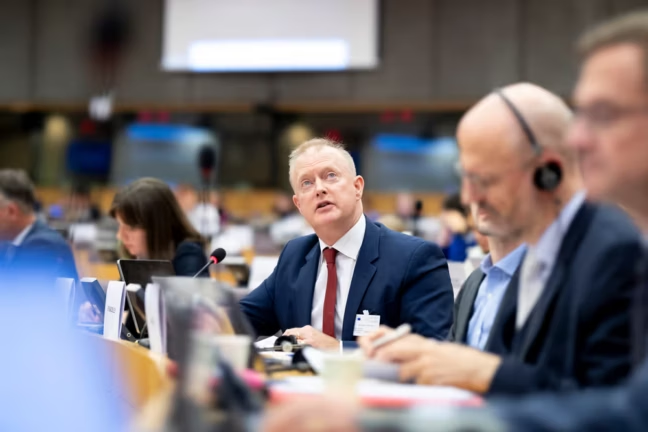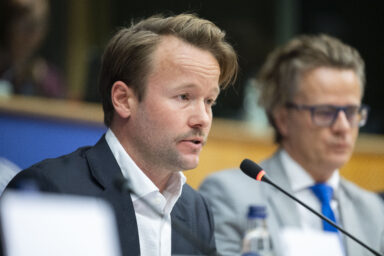Europe needs cash, and lots of it. The Union’s lawmakers are wrestling with a simple-sounding question: should banks be allowed to bundle old loans and sell it on so they can write new ones? Zeal for growth is, once again, running counter to Europe’s penchant for regulatory vigilance.
Four prominent financial experts lined up before the European Parliament’s ECON Committee on 13 October to discuss what the best way was of pouring sorely needed capital into the European economy. The focus was on securitisation, i.e., turning whatever risk there is into sellable securities. Advocates call securitisation a quick American-style way to pump money into firms starved of credit; critics see a slick—also American-style—rebadging of pre-crisis tricks that could pile hidden risks onto investors and the public purse.
On 17 June 2025, the Commission announced a review of the Securitisation Framework, amending the Securitisation Regulation and the Capital Requirements Regulation. The package aims to clarify “resilient” securitisation, trim red tape and tweak capital weights. Monday’s hearing showed broad support for simpler, cheaper issuance, but little agreement on how far to cut.
The debate, focused on the assessment of the reform’s progress, featured a star-studded expert lineup: Jan-Peter Hülbert, managing director of True Sale International; Julia Symon, head of research and advocacy from Finance Watch; Shaun Baddeley, managing director of the Association for Financial Markets in Europe; and Francesco Mazzaferro, head of secretariat of the European Systemic Risk Board.
You might be interested
Increased capacity
“Since 80 per cent of debt financing in Europe is provided by banks to the corporate sector, compared to 20 per cent only in the US, banks in Europe need to be enabled to increase their lending capacity,” argued Jan-Peter Hülbert. He presented securitisation—the packaging and resale of loans—as the quickest way to stretch bank balance-sheets.
Mr Hülbert called securitisation a bridge between bank finance and capital markets. By parcelling loans into slices, or “tranches”, banks can offload part of the risk and write fresh credit. In his example a €100 portfolio is funded by senior, mezzanine and equity notes of €90, €7 and €3 respectively. The trick, he said, is to let outside investors absorb losses while banks keep lending.
“You may compare… the role of securitisation for banks with the role of reinsurers for the insurance industry, where primary insurers underwrite more policies and risk categories because they can risk-share, passing on part of the risks,” Mr Hülbert added. He wants simpler capital rules, so more issuers and buyers create “a deep, liquid, and diversified securitisation market”.
Financing or fiddling?
Julia Symon of Finance Watch was unconvinced. She noted that banks keep most securitised assets on their books and often pledge them at the European Central Bank, rather than funding new projects. Synthetic deals—where risk is transferred but loans stay put—now make up over half the market. Capital freed by such trades can “very well be used by banks to boost their return on equity, pay out dividends or buy back shares,” she warned.
“Securitisation does very little to support the financing of the real economy, and the Commission’s proposal introduced no mechanisms to change these existing incentives,” Ms Symon told MEPs. Without safeguards, she fears the reform could hollow out covered-bond markets and erode the traditional model of relationship banking that serves households and small firms.
She bristled at the idea of loosening global standards. EU rules already deviate from Basel norms, she said, and further dilution “sets a very worrying dynamic in motion in which safeguards are eroded and protections are weakened.” In her closing line she cautioned that “engaging in the regulatory race to the bottom sets a very boring dynamic of which there is no winner but many losers.”

A second chance for a maligned tool
Shaun Baddeley of the Association for Financial Markets in Europe (AFME) insisted securitisation has shed its pre-crisis sins. “EU regulation implemented in 2019 is largely unimpacted by these reforms,” he said; risk-retention and bans on re-securitisation remain. He put annual European issuance at roughly €500 billion and predicted that “these reforms have the potential to unlock by 2030 around 300 billion of lending annually over a large universe of banks.”
Mr Baddeley believes the biggest prize lies with smaller, standardised banks shut out by current capital charges. “One key objective of the CRR reforms is to enable these banks to use it more,” he said, sketching demand- and supply-side tweaks to spark both traditional asset-backed securities (ABS) and so-called significant risk transfer (SRT) deals.
You may compare the role of securitisation for banks with the role of reinsurers for the insurance industry. Primary insurers underwrite more policies and risk categories because they can risk-share, passing on part of the risks. — Peter Hülbert, True Sale International
He also urged Brussels to lift unnecessary due-diligence burdens on investors who already hire asset managers to scrutinise pools. A lingering “stigma” from the global financial crisis, he argued, still weighs on public perception. Showing low default rates for permissible products, he concluded that well-regulated securitisation now matches the credit quality of sovereign and corporate bonds.
Stability first
Francesco Mazzaferro of the European Systemic Risk Board struck a middle note. “We should not confuse instruments with any misuse that they have had in the past,” he began, echoing comments by the incoming financial-services commissioner. Securitisation can “increase the availability of credit” and “strengthen the financial system resilience by transferring risk from originator banks to a more diverse group of investors,” he said.
Yet Mr Mazzaferro stressed limits. Securitisation is “not to channel capital towards highly innovative startups” and will not mobilise household savings on its own. The market remains “rather small…highly concentrated”, with five countries responsible for over 80 per cent of outstanding deals and ten banking groups for about 70 per cent. Even so, he called it “a small but high-quality market.”
He warned against allowing insurers to offer unfunded guarantees, which could raise “both concentration risk and counterparty risk” by tying banks and insurers more tightly together. “Everything will need tests against financial stability concerns,” he reminded lawmakers.
A rethink needed
Resilience, said Mr Hülbert, “was developed particularly for synthetic securitisation transactions”. The concept, now embedded in the Commission’s draft reform, lets a bank that keeps the senior slice of a synthetic deal calculate its own risk weight with finer granularity. That makes sense when the originator “is able to send the data and giving a more risk-sensitive rate”.
But the German financier also warned the European Parliament’s economic committee that extending the same formula to vanilla asset-backed securities “needs a rethink”. Residential-mortgage and car-loan bonds already reflect risk in today’s capital rules; piling on a new layer would only add cost.
Synthetic deals are mostly a risk-management tool for the banks, not a tool to finance the real economy. — Julia Symon, Finance Watch

AFM’s Mr Baddeley backed the call for nuance. Capital surcharges introduced in the last banking package hiked requirements by “50 per cent and up to 100 per cent” over the underlying loan book, he reminded MEPs. Proportionate treatment is therefore overdue, “not only…appropriate, but also…allow for democratisation of significant-risk transfer (SRT) across banks”. If standardised lenders could securitise cheaply, he said, they would unlock fresh credit rather than leave the tool to the largest internal-ratings-based (IRB) giants.
More capital, or more complexity?
Ms Symon remained sceptical. Risk-based capital, she insisted, is no place for policy quotas. Banks that release equity through SRT face no duty to reinvest. “They could also pay out dividends…buy back their shares…retain their earnings.” Securitisation, she said, therefore “does not reduce the EU economy’s dependency on bank financing, but rather deepens it.” Looser charges would simply boost returns without proof of wider benefit.
The Finance Watch head researcher also cast doubt on the idea that ABS could fuel small-firm growth. SME loans display “very different idiosyncratic risks” across 27 legal regimes; pooling them “will not give a simple risk profile”. Synthetic deals, meanwhile, are “mostly a risk-management tool for the bank…not a tool to finance the real economy.” Before easing prudential guard-rails, she urged Brussels to collect evidence and “monitor if this tool has really worked” rather than “engaging in the regulatory race to the bottom”.
Proportionate rules would let standardised banks transfer around €50bn of credit risk per annum by 2030. — Shaun Baddeley, Association for Financial Markets in Europe
MEPs fretted that no one—not even the Commission—knows how many private securitisations take place. Registration of such deals at trade-repositories would plug the gap. Mr Baddeley accepted the need for data but worried about confidentiality: private transactions depend on tight pricing secrecy and light disclosure. Francesco Mazzaferro of the European Systemic Risk Board (ESRB) welcomed the idea. “We are delighted of the idea of having a reporting of the size of the market. We need it,” he said, noting that the ESRB already publishes forensic studies on synthetics and plans one on collateralised-loan obligations.
SME hunger, investor appetite
Mr Mazzaferro repeated his earlier plea to keep reforms simple. If lawmakers insist on a “resilient” label, “one solution to reduce complexity would be to limit the scope…to SRT transactions only.” He reiterated a single red line: letting insurers provide unfunded guarantees in STS (simple, transparent and standardised) deals would increase “both concentration risk and counterparty risk” by binding banks and insurers too tightly.

Asked whether Europe genuinely suffers a shortage of credit for small firms, Mr Hülbert offered nuance. Synthetics, he said, already reference “over 30 million SMEs” indirectly. True-sale deals—public or private—finance working capital, leasing and even rooftop solar panels. He cited Berlin-based start-up Enpal, which used securitisation to fund €750 m of residential solar installations before issuing public bonds. The technique, he argued, can spread from tech darlings to tradesmen if capital treatment stops discouraging senior investors.
Mr Baddeley agreed that SMEs rank second only to corporates in SRT portfolios. „Proportionate rules would let standardised banks transfer around €50bn of credit risk per annum by 2030,” he told MEPs. Yet both men conceded that securitisation cannot force banks into riskier niches; it can only support lending “they want to do anyway.”
Between covered bonds and private credit
Ms Symon countered that genuine equity culture needs equity instruments, not sliced-up debt. Securitisation’s growth spurt since 2020 has been almost entirely synthetic and private—“more than 90 per cent” of that market, she said, escapes public transparency. Any revival must therefore hinge on tougher reporting, not lighter capital.
Some lawmakers asked whether Europe should copy America’s giant mortgage-backed-securities platforms. Mr Baddeley warned against transplanting them wholesale. EU mortgages differ wildly—fixed or floating, with or without pre-payment options—and banks already encumber the choicest loans in covered bonds. That leaves a “significantly reduced” pool for any federal-style conduit.
(Some loans) are so dangerous and so risky that it’s better that private credit makes it instead of banks. — Francesco Mazzaferro, European Systemic Risk Board
Mr Mazzaferro added that a surge in private-debt funds shows investors will find risk regardless. Some loans “are so dangerous and so risky that it’s better that private credit makes it instead of banks”, which face run risk. If securitisation makes that migration safer and more transparent, regulators should welcome it—so long as safeguards stay firm.
Where next?
A final exchange turned to cross-border pooling. Mr Hülbert noted that synthetic deals already blend exposures across countries, and trade-receivable conduits often draw from pan-European seller networks. In contrast, public ABS investors “simply say, I would like to allocate country risk myself.” Full civil-law harmonisation might help one day, he said, “but this is not a hindrance at this stage.”
The hearing hailed the Commission text as “a good start”, yet urged bolder pruning of “inappropriate operating costs”. Draft amendments will surface in December; MEPs are to debate them in January. By then they must choose: double-down on prudence, as Ms Symon counsels, or ease the brakes, as Messrs Hülbert and Baddeley plead. Mr Mazzaferro will watch the dials, ready to raise the ESRB’s flag if zeal for growth outruns vigilance.
Europe needs investment, all four witnesses agreed. Whether securitisation becomes the conduit or a sideshow will depend on how deftly politicians balance growth with prudence.











